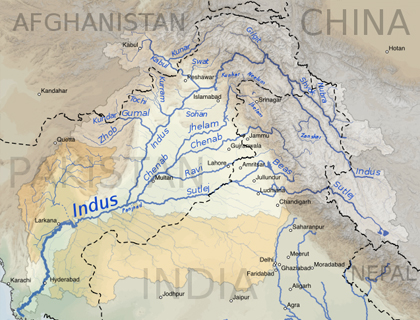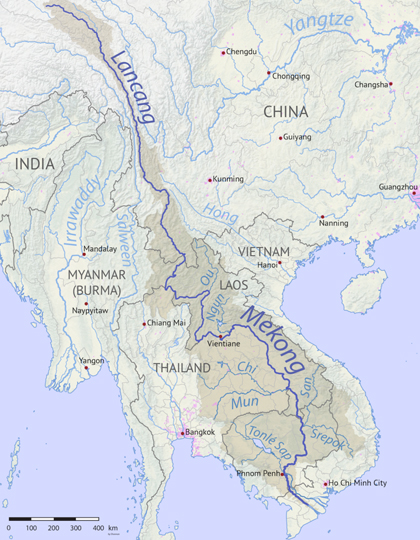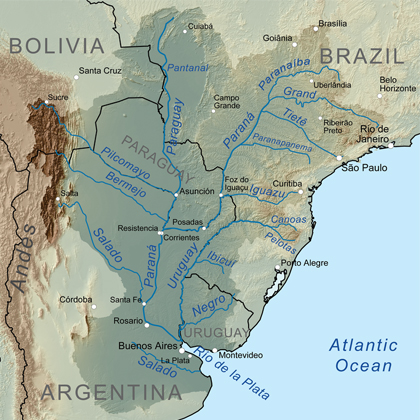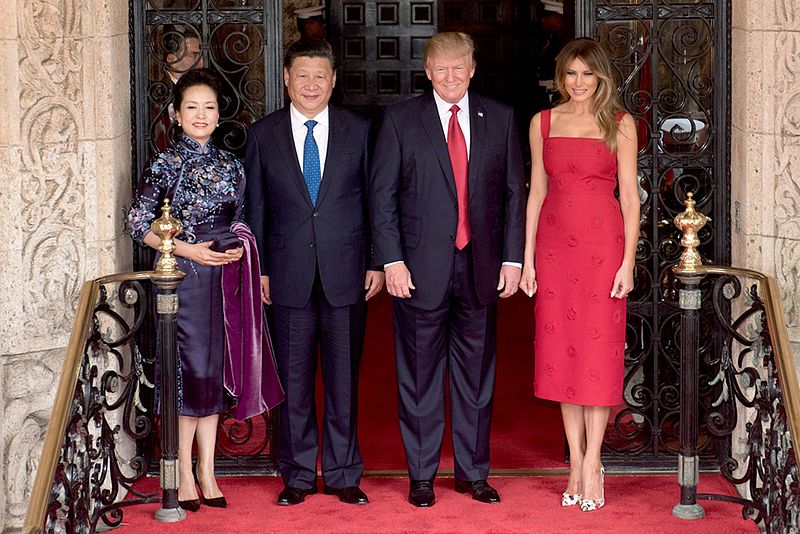Ruta de navegación
Menú de navegación
Blogs
Entries with Categories Global Affairs Asia .

▲Mobilisation of the Royal Thai Armed Forces in 2010 [Roland Dobbins-WC]
COMMENTARY / Álvaro Aramendi Baro
Terrorism is hitting harder and harder in Thailand. The causes of this incipient growth are difficult to pin down. However, the coup d'état of the Royal Armed Forces led by General Prayuth Chan-ocha on May 22, 2014 and, obviously, the subsequent political repressions played a very important role. Nor should we forget the pressure exerted by the BRN (Barisan Revolusi Nasional), which for decades has been fighting for the independence of Pattani (located in the south of Thailand). group revolutionary also operates in northern Malaysia. This terrorist organization is currently used by ISIS. ISIS's strategy, as well as that of Al-Qaeda, is based on encouraging and incentivizing nationalist insurgencies in order to have easier access to those territories under its target.
Despite this, the jihadist influence has taken different paths from those we already know, such as in Iraq or Syria. It is enough to follow the media to guess that the self-styled Islamic State prefers global media expansion to national expansion. This is not the case in Thailand. Both the objectives of terrorism and its communication strategy are national and rather hidden, in the shadows. Because of this, the relationship between them is not entirely evident today.
The status It's not what it should be. If there is one thing Thailand needs today, it is a period of peace in order to recover from past events. In the last century, there have been at least twelve successful coups d'état, the last of them, and not counting the one in 2014, in 2006. There is an urgent need for a quiet period in which to establish a strong foundation, and other structure, for its constitutional monarchy (similar to that of England).
Perhaps the best way to resolve the conflict is to avoid falling into the error of other countries, such as Burma or the Philippines, and to avoid strong repression. That is why, as Crisis Group warns, the best option would be dialogue and not the exclusion of ethnic minorities such as the Rohingya, in the case of Burma, or the Muslim community in Thailand (with a Buddhist majority). Should this happen, the terrorist pressure would become more and more unbearable, until the pot could only explode. Annexation to groups such as ISIS can occur for a variety of reasons, not adding one more to the list is essential.
[Michael E. O'Hanlon and James Steinberg, A Glass Half Full?: Rebalance, Reassurance, and Resolve in the US-China Strategic Relationship. The Brookings Institution Press, Washington D.C., 2017, 104 pages]
REVIEW / María Granados
This short book follows a longer book published in 2014 by the same authors, Strategic Reassurance and Resolve. In the new publication, Michael E. O'Hanlon and James Steinberg —both academics and senior policy makers— update and review the policies they suggest in order to improve the relations between China and the United States. The relationship between both countries, established in the early 1970s, has been subject to changing times, and it has suffered several crises, but it has nonetheless grown in importance in the international sphere.
The short and straight-forward strategic review of the ongoing action provides an insight into the arsenals and plans of the two powers. Moreover, through graphs and numerical tables, it depicts the current situation in terms of strength, potential threat, and the likelihood of destruction if a conflict was to arise.
It also gives an overview of the diverse security matters that need to be monitored carefully, in the realms of space, cybernetics, and nuclear proliferation. These essential matters need not to be disregarded when planning defense strategies; instead officials should cast an eye over historical tensions such as Taiwan, North Korea and the South China Sea, and remember to use the tools that have already been established in the region to prevent the use of hard power, i.e.: ASEAN (The Association of Southeast Asian Nations).
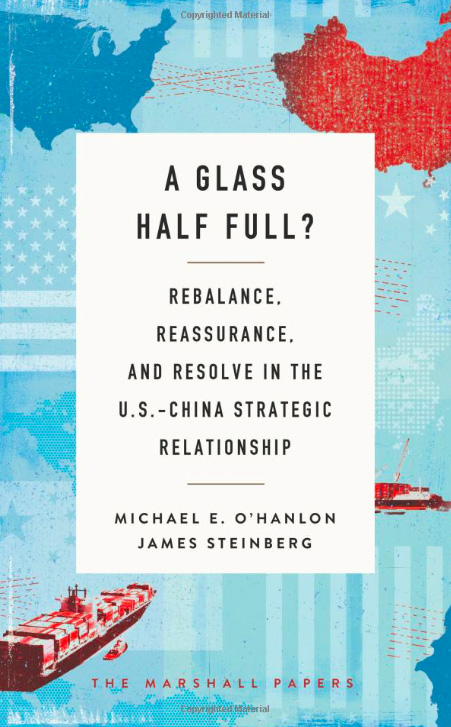 |
Not only does the paper carefully consider the action taken by President Obama and his predecessors, but also cautiously suggests steps ahead in the path opened by Nixon four decades ago. O'Hanlon and Steinberg use bulletpoints to give directions for further developments in the Sino-American relationship, stressing the need for transparency, mutually beneficial exchanges, cooperation, and common ends in common projects.
Some of the ideas are summarised briefly in the following paragraphs:
–True rebalance moves away from mere 'containment' and into a trustworthy alliance. Joint operations that ensure cooperation and reassurance are a key aspect of that objective.
–Confidence building in the area of communications must be reinforced in order to prevent espionage and the spread of piracy, as well as other illegal tactics to gather private information.
–The neutral trend in the broad topic of space, cybernetics and nuclearisation has to advance into a firm and close cooperation, especially in view of the threat that the Democratic People's Republic of Korea poses to the global community as a whole. Intelligence and the recent accusations of Russia's manipulation through the use of the Internet and other technological means can be a target to pursue further negotiations and the signing of international treaties such as The Budapest Memorandum on Security Assurances.
–To abstain from any risks of escalation, the following policies must be regarded: the leveling of military budget growth, and of the development and deployment of prompt- attack capabilities, restraining modernisation, in favour of dialogue and the exchange of information, providing notice of any operation.
The authors conclude that the relationship is not free from conflict or misunderstanding; it is indeed a work in progress. However, they are positive about that progress. The overall outlook of the Sino-American relation is, as the title suggests "A Glass Half Full": there is of course work to be done, and the path has plenty of potential problems that both countries will have to face and resolve in the least damaging way to advance on the common interest; in spite of the aforementioned, half of it has already been done: both China and the US have a goal to fight for: the prevention of war, which would be short and detrimental for all international actors alike.
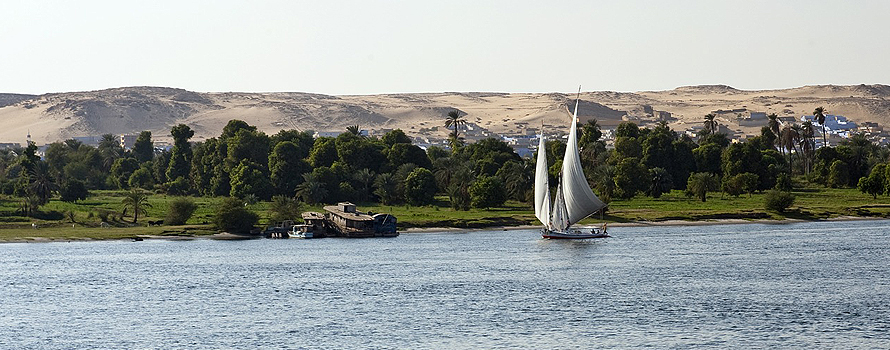
▲Lower Nile River, Egypt [Pixabay]
ANALYSIS / Albert Vidal [English version]
Disputes over control of rivers, lakes, and, in particular, final, are particularly alive today and will intensify in the near future, since, according to the World Health Organization, by 2025 half of the world's population will live in water-scarce areas. Currently, the countries with the most water reserves are Brazil, Russia, the United States, Canada, China, Colombia, Indonesia, Peru, India and the Democratic Republic of Congo. Most water available It is found underground, concentrated in aquifers, or surface water (rivers and lakes). The aquifers with the largest reserves are the Nubian Sandstone Aquifer System (under the Sahara Desert), the Great Artesian Basin (in Australia), and the Guarani Aquifer (in South America). On the other hand, there are a number of rivers in the world that are of exceptional importance, simply because of the enormous amount of population and economic activity that depend on them. Problems arise when these rivers are not part of a single State, but are contiguous or transboundary rivers, and that leads to disputes between some States.
Flashpoints in Asia
Asia is being particularly affected by this problem. There are currently various tensions revolving around water control. One of the most significant cases concerns the use of water from the Indus River, which supports 300 million people and has caused tensions between Pakistan and India. This river is a resource vital for both countries. With the independence of Pakistan, the Indus became a source of disputes. This was addressed by the Indus Water Treaty (1960), which gave India the three eastern tributaries (the Sutlesh, the Ravi and the Beas) and Pakistan the three western rivers (the Indus, the Jhelum and the Chenab). But due to water scarcity, Pakistan has recently protested against the construction of dams on the Indian side of the river (in Indian-administered Kashmir), which restrict the water supply to Pakistan and reduce the flow of the river. India, for its part, defends itself by saying that such projects are covered by the Treaty; Still, tensions don't seem to be abating. For this reason, Pakistan has order the World Bank to appoint the president of an international arbitration tribunal in order to resolve the dispute. This problem of water reserves is at the heart of the confrontation in Kashmir: without an adequate supply, it would not take long for Pakistan to become a desert.
|
Watersheds in Central Asia [Wikimedia Commons–Shannon I] |
Indus River Basin [Wkiwand] |
In Asia, there is also the dispute over the Mekong River, which runs through Cambodia, Vietnam, Laos and Thailand. This conflict revolves around the construction of dams by various countries, as well as the exploitation of the resources provided by the Mekong River. Eleven dams along the river are planned, which would produce a large amount of electricity and be beneficial to some countries, but in turn could threaten the food security of millions of people. The affected countries (Cambodia, Vietnam, Laos and Thailand) formed the Mekong River Commission (MRC) in 1995. This commission was formed in order to promote dialogue and promote the fair and equitable use of the river's waters. The MRC has mediated between countries several times; in 2010 for the construction of a dam by Laos and Thailand, and the same status It happened in 2013. Talks have not been result and there are fears for the lives of millions of people, who could be affected if the conflict escalates.
The ineffectiveness of this body could be summed up as follows: decisions on the construction of dams are made directly without submitting them to the MRC, and construction companies put such pressure on governments that it is very difficult to carry out environmental impact assessments. Moreover, since it is not a binding treaty, members end up ignoring its guidelines and preferring to "cooperate" in a broad sense. In any case, the talks are continuing although, at the moment, the MRC does not seem able to assume the weight of the negotiations. This gives the conflict an uncertain and dangerous future.
A third source of friction is the ex-Soviet region of Central Asia. During the Cold War, these regions shared resources as follows: the mountainous republics (Tajikistan and Kyrgyzstan) had abundant water, and supplied it to the downstream republics (Kazakhstan, Turkmenistan, and Uzbekistan) to generate electricity and irrigate crops. In turn, the downstream republics supplied gas and coal to Tajikistan and Kyrgyzstan during the winter. But when the USSR collapsed, all that changed and there began to be water shortages and power cuts, as these independent countries decided to stop sharing water and energy. As the International Crisis Group think-tank proclaims, "the root of the problem lies in the disintegration of the system of sharing sources imposed by the Soviet Union in the region until its collapse in 1991."
Thus, Kyrgyzstan and Tajikistan have decided to build hydroelectric dams on the Syr Darya and Amu Darya rivers to produce their own energy and thus cope with the constant blackouts (potentially lethal in winter). This, of course, will limit access to water for millions of people living in the other three republics, which has led to small-scale conflicts. Threats have also abounded, such as that of Uzbek President Islom Karimov, who in 2012 said the following: "Water resources could become a future problem that could lead to an escalation of tensions not only in our region, but across the continent"; He added: "I won't name specific countries, but all of this could deteriorate to the point where the result It wouldn't just be a confrontation, it would be wars." Despite the threats, the projects have continued on their way, and therefore an increase in tension in the region can be expected.
|
The Nile Course [Wikimedia Commons–Yale Environment 360] |
Mekong River Basin [Wikimedia Commons–Shannon I] |
Control of the Nile
The Nile River appears as source of tension between various African countries. To understand the existing problem, we must go back more than a century. As early as 1868, Egypt attempted to occupy Ethiopia in order to gain control of the Nile. In 1929 , agreements were signed during the colonial era, in which the waters of the Nile were divided. In these agreements (which were reaffirmed in 1959), Egypt obtained most of the water for its use, while Sudan obtained a small share. The remaining 9 countries in the Nile basin were removed from the treaty. At the same time, Egypt was allowed to build projects on the Nile River while the rest of the riparian countries were forbidden to do the same without Egypt's permission.
In 1999, the Nile Basin Initiative was created: a commission charged with organizing a fair distribution of the Nile's water and resources. But as it did not have the expected effect, in 2010 the agreement of Entebbe (for Ethiopia, Rwanda, Uganda, Kenya, Tanzania and Burundi). This agreement, deeply disputed by Egypt and Sudan, allows riparian countries to build dams and other projects, thus breaking the restrictions imposed by colonial treaties. Moreover, this has shifted the balance in the region, as Egypt and Sudan have lost their monopoly on the Nile's resources.
It is vital to understand the status of these actors. The Nile rises in several countries, and ends up passing through Sudan and Egypt to flow into the Mediterranean Sea. Egypt, in particular, is a country totally dependent on the Nile River. It receives more than 90% of its fresh water from this river, and its industry and agriculture need the Nile to survive. Until a few years ago, thanks to colonial treaties, Egypt had exercised a monopoly on the use of water; But recently, the status it's changing.
Therefore, the confrontation has basically arisen between Egypt and Ethiopia (where the Blue Nile is born). The latter is a country with more than 100 million inhabitants, which in 2011 had a project of dam construction: the Grand Ethiopian Renaissance Dam (GERD). With an investment of 4,700 million dollars, this dam would solve Ethiopia's energy deficit, and would eventually turn this country into a net exporter of electricity (it would produce 6,000 MW per year). The downside is that the dam will be fed with water from the Blue Nile, a tributary of the Nile River. The danger of evaporation of more than 3 trillion cubic meters per year and the reduction of the flow rate to fill the reservation it could catastrophically affect Egypt. In addition, the dangers arising from the overuse of water are compounded by population growth and the demand for better redistribution of water among riparian countries.
This issue has led to tensions between the two countries: in 2010 an email from a senior Egyptian commander was leaked to Wikileaks stating: "We are discussing military cooperation with Sudan against Ethiopia, with plans to establish a base in Sudan for Egyptian Special Forces with a view to attacking the country."project GERD." Egypt also thought of preparing support for proxy rebel groups in Ethiopia, to destabilize the government. In any case, we must bear in mind that Egypt has always tended to use aggressive rhetoric towards all issues related to the Nile (source of life, the engine of its Economics), but in reality the nation of the pharaohs is not in a position to launch armed actions, since its domestic problems have worn down the country, thus losing its position of clear predominance in the region.
But not all the future is so bleak. In March 2015 , a agreement A preliminary agreement between Egypt, Ethiopia and Sudan on the Renaissance Dam and the sharing of water, accepting Ethiopia's right to build the dam without damaging the water supply of Egypt and Sudan. Although these two countries are alarmed at what will happen once the reservation This is a first step towards an era of cooperation. Abdel Fattah el-Sisi himself (Egypt's president) said at the convention: "We have chosen to cooperate and trust each other, for the sake of the development". Finally, in November of the same year, it was not possible to approve an independent commission of inquiry to look at the consequences of the dam, since after Sudan accused Egypt of using part of the Sudanese quota, a war of declarations began, which jeopardized the fragile cooperation between these countries.
Such cooperation in the field of water resources will have a beneficial impact in many other areas and, although a failure of the negotiations cannot be ruled out, it is likely that thanks to the construction of the GERD and regional cooperation, the ties between these countries will become stronger, which can mark the starting point of a new era of peace and peace. development in this region.
A case of cooperation: the Paraná
The Paraná, a border and cross-border river that rises in Brazil and crosses Paraguay to flow into the Rio de la Plata, is a very different example. Its basin is linked to the Guarani Aquifer (one of the largest water reserves in the world), and that is a guarantee of the large volume of water that this river has throughout the year. For this reason, many hydroelectric power plants have been built, taking advantage of waterfalls and rapids. On the other hand, the importance of this river on a political and economic level is core topic; the Paraná and the La Plata Basin feed the most industrialized and populated area of South America. That is why cooperation has been particularly important.
|
The Paraná, central axis of the La Plata basin [Wikimedia Commons–Kmusser] |
The Itaipu Dam (the second largest in the world and the first in world production) is a binational dam, built by Paraguay and Brazil. It was the result of intense negotiations (not always easy), and now produces an average of 90 million MWh (megawatt-hours) per year. Even so, there was not always concord between Paraguay and Brazil: in 1872 disputes over borders began. After many useless agreements, it was agreed to flood the disputed territories and create a hydroelectric dam. The reluctance that the initiative aroused in Argentina, because the regulation affected the flow that, downstream, would continue to the Río de la Plata, resulted in a three-way pact in 1979. In 1984 the dam became operational. Today it is administered by the Itaipu Binational Entity, a business public-private between Paraguay and Brazil, and supplies more than 16% of the total energy consumed in Brazil, and more than 75% of that consumed in Paraguay. Although the environmental impact was great, Itaipu has promoted campaigns to maintain biological reserves and protect fauna and flora. In addition, it has reforested large areas around the reservoir, and ensures the quality of the water.
This is a clear example of the benefits that can be brought by a reasonable and shared use between countries that decide to cooperate. Thus, countries that are parties to some of the current controversies should look to these examples of behaviour which, although not perfect, can be learned a great deal from them.
Although water can be the source of disputes between peoples and nations (such as the cases cited), it also offers very advantageous opportunities (what happened on the Paraná River or the Nile) for countries that manage to cooperate. This cooperation, initiated to avoid conflicts over water, can lead to new stages of harmony and strengthen trade, political and security relations. Is core topic, then, to show how an attitude of willingness to negotiate and cooperate will always have positive consequences for countries that share river flows.
[Riordan Roett, Guadalupe Paz (Eds.). Latin America and the Asian Giants: Evolving Ties with China and India. Brookings Institution Press, 2016, 336 pages]
review / Ignacio Urbasos Arbeloa
Trade between Latin America and the Asia-Pacific region has grown over the last decade at a dizzying rate of 21% per year[1]. However, China's prominence has overshadowed and concentrated the vast majority of academic analyses, leaving other relevant actors such as India in the background. This book by Riordan Roett, Guadalupe Paz and other collaborators from different parts of the world offers an interesting comparison between the two "Asian giants" in their relations with Latin American countries in a new global context. This review, will focus on India's rise in the region, although references to China are inescapable.
Historical ties between Latin America and India, though weak, have existed since the colonial period. Today, one million people[2] descendants of Indian migrants live in the Caribbean, a fact that can be considered an opportunity to generate channels of dialogue, however the magnitude of the Indian diaspora eliminates any trace of exceptionality. Another interesting element directly links India and Brazil, two countries that share to some extent the bequest They have been champions of South-South cooperation to this day, an approach shared by Lula and Dilma as well as Modi. In the section historically, India's relevance is much greater than that of China, which lacks relevant references partner-cultural activities in the region.
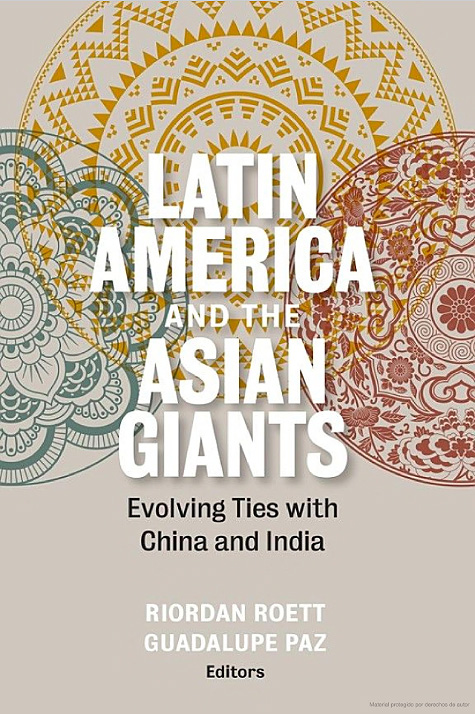 |
The growing economic presence of the two Asian giants in Latin America has not gone unnoticed in the discussion politician. Historically, left-wing sectors have been more supportive of increasing trade relations with China, considering it a way to achieve the continent's emancipation and independence from the United States. The right, on the other hand, has been reluctant to have a greater presence of China, aligning itself in the case of the countries of the Pacific Alliance with the TPP, which until the arrival of Trump was intended to be a free trade agreement aimed at increasing the presence of the American continent in the Asia-Pacific outside of China[3]. In the authors' opinion, Latin America lacks a cohesive narrative and strategy on China, thus drastically reducing its negotiating capacity and influence over the Asian country. The case of India is different, as the volume of trade is still a tenth that of China, being a democratic country, an ally of the US and with a better image on the continent.
Despite the fact that the vast majority of Latin American exports to Asia are made up of commodities and imports are made up of manufactured products, there are subtle differences that explain India's better image in the region. First, Chinese imports are much more diversified than Indian imports, generating a general perception of destruction of the industrial fabric and local jobs due to greater competitiveness due to economies of scale and the distortion of the yuan. Likewise, what India exports to Latin America are socially valued products (such as generic drugs, which have reduced the price of medicines) and cheap vehicles, while Indian businessmen set up information companies, which have generated 20,000 jobs in the region.
In terms of imports, both India and China concentrate their purchases on natural products. profile India's most energetic and China's most mining. Both countries concentrate a huge demand for soybeans, a product that agreement with Riordan Roett it will gradually become increasingly important due to its versatility as a feed, feed and biofuel source. It is important to note that Latin America is one of the keys to the energy and food security of these countries, which are facing this enormous challenge The size of its population is derived differently: India is betting on private investment and China on long-term purchase agreements for its state-owned companies. A possible collision between the two Asian giants for access to these markets cannot be ruled out, with the geopolitical implications that this entails.
In terms of India's financial positioning in Latin America, the reality of the sample an almost testimonial presence compared to that of China. However, it should be noted that Indian investment and loans are viewed much better than Chinese ones. Overall, India acts as a partner This is not the case with China, whose actors are more accustomed to dealing with a complex bureaucracy than with a democratic system. Likewise, Chinese loans, increasingly present in certain economies such as Venezuela or Ecuador, have proven to be less advantageous than those of international organizations such as the IMF or IDB as they have higher interest rates and are linked to strict conditions for the purchase of goods. All of this makes India a partner friendlier to the public: a challenge that it will have to face as its presence in the region increases and with it its true way of acting abroad can be appreciated, still an unknown.
In final, India's role in the region is promising but still limited in scope. The annual growth of trade between that country and Latin America was 140% between 2009-2014[4] and India has already signed the first free trade agreements (with MERCOSUR and Chile), although of small magnitude. It should be noted that this is mainly an inter-industrial trade, in which Latin American countries export primary products and manufactures based on natural resources and import manufactures of different technological intensities, which limits the potential for deeper economic relations between the two regions[5] and condemns them to fluctuations in commodity prices. The fact that it takes between 45 and 60 days for a freighter to arrive from the Chilean coast to Indian ports is a real barrier to trade, however there are many reasons to expect India to have a greater regional presence, such as its excellent relations with Brazil, the expectations of annual growth of more than 7% of its GDP and the inescapable importance of Latin America in guaranteeing the energy and food security of the region. the growing population of the Asian country.
[1] CELAC: International Trade and Regional Division DATA.
[2] NRIOL: Non Residents Indian Online DATA
[3] Wilson, J. D. (2015). Mega-regional trade deals in the Asia-Pacific: Choosing between the TPP and RCEP?. Journal of Contemporary Asia.
[4] ECLAC, N. (2016). Strengthening the relationship between India and Latin America and the Caribbean.
[5] ECLAC, N. (2012). India and Latin America and the Caribbean: Opportunities and Challenges in Their Trade and Investment Relations.
DOC. DE work / Iñigo González Inchaurraga
SUMMARY
The main, though not the only, element of contention between the United States and China is Taiwan. While Washington maintains a one-China policy, Beijing defends the "one China" principle, proclaiming that there is only one China in the world and that both the island of Taiwan and the mainland are the same People's Republic of China. The Chinese authorities also maintain that Chinese sovereignty and territory cannot be divided. In Beijing's eyes, Taiwan is a renegade province that emerged from the Chinese civil war, so reunification is the only option for the island's future. This reunification should preferably take place peacefully, but the use of force cannot be ruled out if Taiwan were to seek de jure independence. For its part, the government of Taipei claims its status as a sovereign state. The fact is that at the end of the 2010s, it is difficult to continue asking China to comply with international law in relation, for example, to the Permanent Court of Arbitration ruling and territorial disputes in the South China Sea, while Taiwan remains an anomaly that violates the same international law that Beijing must comply with in accordance with UN rules on the Law of the Sea.
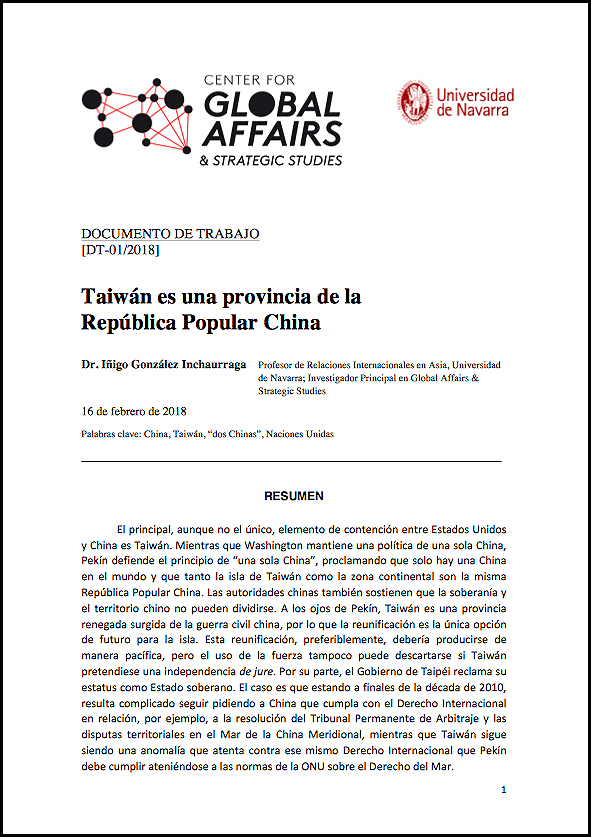 download the complete document [pdf. 432k]
download the complete document [pdf. 432k]
U.S.-China relations do not satisfy either country; They probably never will. They must try to deal with them, peacefully

▲meeting between Xi Jinping and Donald Trump [White House video screebshot]
ANALYSIS / María Granados
The National Security Strategy presented in December by Donald Trump label China and Russia as "rivals" of the United States. It portrays those two countries as actors that "challenge the power, influence, and interests" of Washington and "attempt to erode the security and prosperity" of Americans. Although the document also considers "renegade" states such as Iran and North Korea, and transnational organizations, both jihadist and organized crime, a threat, the arguments of the new US administration are especially focused on China. The Asian nation appears as the great obstacle to the realization of the "America First" promised by Trump, because of its unfair trade and monetary practices.
Thus, the first National Security Strategy document of the Trump era corroborates the speech which he had maintained as candidate. During the election campaign, Trump spoke of China as a "currency manipulator" and accused it of artificially keeping the yuan low. He also threatened Beijing with starting a trade war, complaining about the economic consequences for the U.S. of China's excessive trade surplus in bilateral relations, as well as the reduction of jobs in U.S. manufacturing. Shortly after being elected, before the inauguration of his term, Trump provoked a diplomatic friction with China by talking by phone with the president of Taiwan.
However, since his arrival in the White House, Trump has been concerned with ironing out those rough edges with China. He pledged to uphold the One China Policy, retracted his criticisms, and met in Florida with President Xi Jinping, agreeing to respect each other's sphere of influence and not intervene in each other's internal affairs. This, along with an incipient partnership in the sanctions against North Korea, it seemed to be giving birth to a rapprochement that has not yet materialized. In fact, the U.S. National Security Strategy's official "rival" treatment of China somewhat breaks with a long period of mutual acceptance that began in the 1970s.
Nixon's Opening
The United States and China started from serious antecedents: the Korean War (1950-1953), which pitted China and the USSR in the North against the American-backed South, of which the Vietnam War (1955-1975) was a collateral consequence; and the nuclear danger that began in 1949, the year in which the USSR carried out the first nuclear war. essay effective. For Washington, from an ideological and military point of view, China was an international actor that should be controlled. For Beijing, in alliance with the Soviet Union, it was urgent to spread the speech communism about the "imperialist enemy," which he repeated with intensity throughout the early years of the Cold War.
In 1969, the new U.S. president, Richard Nixon, included in his speech inauguration of mandate one reference letter against isolationism (1). From the other side of the world there were also new messages: the distance that Mao began to establish in relation to the USSR due to its border conflicts. This upset the triangle of international relations that existed in those years of the Cold War (China, USSR, USA), and began to create a bond between Beijing and Washington.
In this way, the first signs of approximation began to appear. In 1971, the U.S. voted to allow Taiwan to join the committee of the United Nations Security Council will be occupied by the People's Republic of China. In 1972 the statement of Shanghai, which established the instructions for the Sino-American rapprochement and which was embodied in five principles:
1. The One China Policy: Establishing diplomatic relations with China meant not being able to establish them with Taiwan, and vice versa, since both claim to be the true and only China.
2. Not supporting Taiwan independence.
3. Do not support the possible invasion of Japan.
4. The peaceful resolution of the conflict with Taiwan, reducing military installations on the island.
5. A commitment to continue to be peaceful allies in the pursuit of lasting cooperation.
Since the rapprochement of the 1970s, relations between the two countries have been heavily influenced by Washington and Beijing's attitude toward Taiwan and the two Koreas, in a sort of indirect Sino-American relations.
|
▲meeting bilateral meeting at Mar-a-Lago, Florida, in April 2017 [White House] |
The Question of Taiwan
The self-styled Republic of China had been the main obstacle to the complete normalization of relations, as seen with the statement of Shanghai. Effective reunification by (mainland) China was prevented by U.S. troops.
After 1973 we find two important documents: the so-called Taiwan Relations Act, by which the United States recognized the island as before, but not that it was a sovereign nation, and the Taiwan Relations Act. statement Set (sometimes referred to as "Second statement of Shanghai"), drastically cutting arms sales to Taiwan. In 1979, Washington and Beijing exchanged ambassadors, and the Americans ceased formal diplomatic relations with Taiwan.
Around 1980, the policy advocated by the mainland Chinese government was "one country, two systems", offering Formosa the exceptionality of a different and economically independent political system, but being part of the one China. However, this formula did not meet the wishes of the twenty-third province for independence. By 1985, the island's government was firmly moving towards democracy (2).
In the late 1990s, Beijing threatened Taiwan with military exercises in surrounding waters, in which missiles were deployed, prompting a forceful response from the United States: sending two aircraft carrier battle groups to the region; In doing so, Washington showed a clear determination to protect the former ally because of its strategic importance.
The status The current situation remains complex. No direct ties have been established between China and its rebel province through messaging or telecommunications; Neither are postal or parcel shipments sent, nor is there a direct connection of flights. Face-to-face meetings between delegates have been infrequent and not very productive.
The North Korea Problem
The Democratic People's Republic of Korea, for its part, is a particularly critical point in Sino-American relations, which also affects South Korea and Japan, which in turn are allies of the United States. Pyongyang has already carried out six underground nuclear tests and continues its missile launches over the Sea of Japan.
China is North Korea's only ally: it is its biggest partner commercial and its main source of food and energy. Beijing has historically opposed tough international sanctions against its neighbor. The will to survive communism is essential when it comes to understanding the close relationship between the sui generis Korean dictatorship and China. It's easy to guess why: if Kim Jong-Un's regime falls, Xi Jinping's could be destabilized. A refugee crisis, with thousands of North Koreans crossing the 1,400-kilometer border bordering the two countries, would have serious effects on the Asian giant. Although they remain strongly linked to Pyongyang, the Chinese have pushed for the resumption of the Six Dialogue and have accepted the application of certain international sanctions.
Trump's blunt assertion that "if China isn't going to solve the North Korea problem, we will" doesn't really dispel doubts about what might happen if Pyongyang crosses the threshold of nuclear capability. Certainly, as the Kim Jong-Un regime has approached that threshold, Beijing has increased its diplomatic, financial and commercial pressures on its neighbor (3). But the possibility that North Korea is already on the verge of reaching its goal The strategic strategy leaves the United States faced with the dilemma of military action, which can hardly be both effective and limited, or having to settle for a policy of containment.
Over the years, Washington has tried to encourage North Korea to irreversibly forget its nuclear program, proposing in return a reward consisting of financial aid, diplomatic advantages and the normalization of relations. At the same time, South Korea hosts 29,000 U.S. military personnel. In March 2017, executive orders from the President and the congress The U.S. government went beyond sanctions: a defense system known as THAAD (Terminal High Altitude Area Defense) (4) was programmed as a preventive measure against a possible attack by the North and with the aim of protecting the environment. goal to ensure the stability of the region.
The THAAD battery is particularly interesting to analyze, because of the double perspective it presents. Their limited range and capability should not worry China, as the interceptors would not be able to hit Chinese intercontinental ballistic missiles at any point in their trajectory, from almost any of the possible launch locations. As such, neither Washington nor Seoul should present the system as a form of retaliation against Beijing for its failed sanctions on North Korea. Unfortunately, U.S. and South Korean officials suggest that the purpose of the installation of the THADD system is to send a warning message to China. This is somewhat counterproductive, since it only offers reasons to justify the nuclearization of the Asian hegemon, in the face of the apparent degradation of its medium-range technology, that of the second Degree nuclear response (second-strike capability).
Mutual dissatisfactions
If the issues of Taiwan and North Korea have occupied a large part of the diary In the bilateral relationship, the issue of China's economic transformation, since its impetus by Deng Xiaoping, has been central to the direct relationship between China and the United States.
Gǎigé kāifàng (reform and opening-up) emphasized modernization and economic and political reform. This led to normalized diplomatic relations and thedevelopment bilateral trade and investment. Cooperation in subject The political, economic and security relations with the former "American imperialists" were based on the prevention of terrorism and the proliferation of nuclear weapons, and the maintenance of peace on the Korean peninsula.
However, there are still unresolved issues. U.S. dissatisfaction stems from China's human rights policy and its financial moves to devalue the currency as a measure to control inflation. These monetary movements call into question the control of the market by the American hegemon, which currently has greater weight and primacy, among other things, because the dollar is the international currency of exchange (it could thus "export its inflation" to Beijing). Washington is also concerned about the U.S.'s dependence on imports from China, which creates a large bilateral trade deficit for Americans. Another potential problem is the sale of missiles and nuclear technology to third States in the Middle East and Asia.
From the Chinese perspective, their dissatisfaction is due to the U.S. arms sales to the rebel province (Taiwan), the defense system established in South Korea (both the THAAD system and the U.S. government). financial aid and a U.S. foreign policy that Beijing dismisses as threatening, imperialist and domineering.
Ways of cooperation
The U.S. consideration of China as a "rival," as stated in the Trump Administration's first National Defense Strategy document, is based on the realization that the Chinese regime is not moving towards democracy as many in the rest of the world had hoped. "For decades, U.S. policy was based on the belief that support for China's rise and its integration into the post-war international order would liberalize China," the document says, noting that Beijing is not sliding toward a regime of political freedoms and respect for human rights, so Washington can no longer be as condescending to Beijing as it once was.
Probably, without China's assumption of the values and principles that give meaning to the United States, a real and confident rapprochement between the two superpowers is impossible. Still, for the survival of both, broad cooperation between them is necessary.
Although a war between the United States and China is not impossible, it is unlikely for a number of reasons, as Steinberg and O'Hanlon argue in Strategic Reassurance and Resolve (2015):
–The common objectives of economic prosperity, the exchange In terms of trade, interdependence, both at the stock market, financial and business levels, make a military confrontation very harmful to both countries. In addition, China has progressively adopted measures against fraud and destabilization by computer manipulation, at the behest of the United States; The issue of cyberespionage, although it continues to provoke mutual disagreements, is regularly addressed by both countries in their bilateral meetings, aware that it is likely to become more important over the years.
The South China Sea is a trade route that has never been closed, although it is a source of dispute to be taken into account, since they remain unresolved even though they have been brought before the Court dealing with the Law of the Sea (following the United Nations Convention on the Sea). The United States has strategic and commercial interests in the region that link it to its allies (Japan and South Korea), so it could be a source of tensions. In any case, it does not currently appear that China wishes to provoke a military escalation in the area, although it has established instructions on artificial islands and moved troops.
The ASEAN code of conduct for the South China Sea, which prevents the use of force, may cause Beijing to rethink increasing its aggressiveness in the region. That push by ASEAN for China to stop claiming maritime sovereignty that has been rejected by the international community are points against the war.
There are a number of joint counter-terrorism (ISIS) and anti-piracy operations involving the two superpowers.
China has increased its financial aid and its work in support of UN peacekeeping missions.
Faced with a scenario of no understanding between Beijing and Washington, but at the same time of no armed confrontation, the following actions should be suggested:
A negotiation that would include fewer arms sales to Taiwan by the US in exchange for greater security on the coasts, and a proportional reduction by China of threats to the island.
–Greater cooperation and transparency in the conduct of arms and troop movements, militarization, restructuring of the armed forces, and military exercises in the Pacific.
–Creation of joint organisations to combat organised crime and cyber-attacks, in particular threats to civilian infrastructure.
- Support and coherence in the prevention of nuclear escalation. Negotiation to reach a firm conclusion on how to weaken the Pyongyang regime. Serious and coherent criticism, knowing the impossibility (as well as harm) of its direct overthrow.
-----------------------------------------
(1) "We seek an open world--open to ideas, open to the exchange of goods and people--a world in which no people, great or small, will live in angry isolation.
We cannot expect to make everyone our friend, but we can try to make no one our enemy". Inaugural Adress (January 20, 1969)
(2) It was the first time that the Democratic Progressive Party succeeded in pressing the elections to the National Assembly and the Legislative Yuan and forming a unified coalition against the Kuomintang. In 1992, the first free legislative elections were held in Taiwan.
(3) "China will be most likely to put diplomatic and financial pressure on North Korea if it believes that failing to do so will lead the United States to destabilize the regime," write Joshua Stanton, Sung- Yoon Lee, and Bruce Klingner in Foreign Affairs.
(4) The system typically has between 48 and 62 interceptor missiles with ranges of up to 200 kilometers, supported by radar with a range of up to about 1,000 kilometers
The project 'One Belt-One Road' aims to consolidate China's rise as a superpower.
Xi Jinping's ambitious initiative to connect China to the rest of the Eurasian continent may prove costly and difficult. But unlike the overland route through the Central Asian republics, the sea route may not take long to become a reality on certain stretches, as China has already built some ports along part of the route.
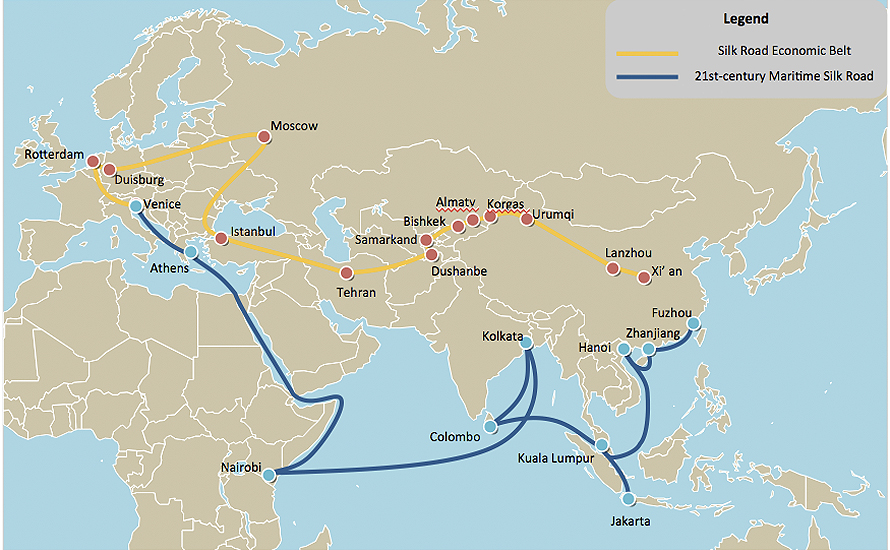
▲The land and sea routes of the Chinese initiative [yourfreetemplates].
article / Jimena Puga Gómez [English version].
Following Chinese President Xi Jinping's 2013 revitalisation of the ancient Silk Road speech , the initiative that started as an idea has become the Beijing government's biggest economic challenge: a revolution that, if realised, will change the Asian continent's passenger, freight and hydrocarbon transport infrastructure, as well as high-tech. Dubbed OBOR-OneBelt-One Road, the plan is intended to be the core topic of China's rise as a regional superpower.
The OBOR initiative is a grand plan to reshape China's strategic environment, project Beijing's economic power, secure the communist country's access to energy and mineral supplies, and boost economic growth in the west of the People's Republic. OBOR seeks to achieve these goals by fostering greater and faster connectivity between China and Europe through intermediate points in Central, West and South Asia, as well as with Russia.
For its part, the maritime route that will form one of the pieces core topic of the OBOR initiative, also known as the Silk Road of the 21st century, counts on the fact that seven of the ten largest ports in the world are in China and, as is well known, these infrastructures make the Asian giant an important exporter of port services management .
The Eastbound Maritime Silk Road will start in Fujian province and pass through Guangdong, Guangxi and Hainan, before heading south to the Strait of Malacca. From Kuala Lumpur, the Route will continue to Kolkata and Colombo, then cross the rest of the Indian Ocean towards Nairobi. From there, it will travel through the Horn of Africa, seeking to cross the strategic Gulf of Aden to the Red Sea. Beijing's plan aims to create sufficient infrastructure to allow Chinese ships to safely reach the Mediterranean after sailing through the Suez Canal. But the People's Republic's ambition does not stop at the EU's doorstep, as China wants to reach Athens via the Aegean and from there to Venice, where it will look for land routes to move its goods throughout the Union. Chinese investment has focused, among other things, on the port of Piraeus, with a new logistics centre, and on the development of a network of logistics infrastructures through the Balkans and Hungary.
The South Pacific has also been included in this strategic route map devised in Beijing. Thus, the maritime Silk Road has two routes. The first, as mentioned above, originates on China's east coast and, via the South China Sea, aims to establish strategic control of the Spratley Islands, the Strait of Malacca and the entire Indo-Pacific area, including the Bay of Bengal, in order to reach the heart of Europe. The second sea route will also cross the South China Sea to direct its ships to the coastal ports of the South Pacific. In this way, China would also control the routes for the essential raw materials that come from Latin America.
Although this is a long-term economic project deadline , the Chinese government has already begun the construction of certain infrastructures and the necessary negotiations with different countries. A clear example is Germany. The European Union is China's largest trading partner , while the People's Republic of China is the EU's second largest provider . sample . Germany is a country that not only enjoys an excellent reputation as a reliable partner in China, but is also regarded as "Europe's trade gateway". test This is why, at a meeting in Duisburg, the world's largest inland port and an important transport and logistics hub in Europe, Chinese President Xi Jinping proposed to Germany "to work together to realise the ambitious project of the revival of the economic belt of the new Silk Road of the 21st century". Germany and China are currently connected by the Chongqing-Xinjiang-Duisburg international railway line.
The ports built by China at Hambantota and Colombo in Sri Lanka, the China-Suez Economic and Trade Cooperation Zone in Egypt, Kazakhstan's negotiation of the right to clear its imports and exports through the Chinese port of Lianyungang, and a new alliance between ports in China and Malaysia are further examples of China's ability to leverage its new skill as a port moderniser and manager to support its strategy.
The New Silk Road initiative is a project that will require multi-billion dollar investments in order to build smooth, safe and efficient transport infrastructures. The effects of this economic network ensure benefits not only for China, the leader of the OBOR initiative, but also for all countries affected by it. However, the financing of project is still a question mark that needs to be clarified.

▲The H6K of the Chinese People's Liberation Army Air Force, in flight over the Pacific
COMMENTARY / Ignacio Cristóbal Urbicain* [English version]
Only three countries in the world have strategic or long-range bombers (the US, Russia and China). The mission statement of this subject Weapons is to project the force at very long distances, usually within enemy airspace in order to destroy, with its significant armament load, strategic objectives, i.e. industry, infrastructure, logistics, etc. It is also an important deterrent.
In the case of China, its strategic aviation mainly has the latter mission statement with respect to the defence of their interests by projecting a threat to very distant distances, i.e. avoiding rapprochement and entrance of the U.S. Navy's battle groups (aircraft carriers and attack cruisers) to the South China Sea.
For this task, China has the Xian H-6. This aircraft is a derivation of the Russian Tupolev Tu-16 developed 60 years ago. In 2007, the Chinese modernized their H-6s by changing the old engines to reach a longer range (3,500 km). Again Russian engines were chosen, although there are sources who have said that a new Chinese engine (WS-18) is being developed. A general electronic modernization and the air-to-ground radar were also carried out. Their ability to pursue targets is unknown. The bomb bay was reduced to put another inner fuel tank and modified to house the Wayside Cross CJ-10 with a range of 2,200 km. In this way, the H-6K was created, much more modern than the previous version, which maintains the possibility of carrying nuclear weapons, as well as the YJ-12 supersonic anti-ship missiles.
A squadron of 15 of these aircraft (i.e., the issue that Jane's Defence thinks are in service) can fire around 100 missiles, creating a major problem for a number of people.group naval with bad intentions. Note also that in recent weeks the H-6Ks have been seen for the first time with bombs on the outer wing mounts.
The future
In December 2016, sources in the Chinese Ministry of Defense confirmed the rumors about the development of a new long-range bomber. This new project it's probably sneaky (very leave It can be used to ensure that it has been able to load a large amount of conventional weaponry in an internal hold, which will improve stealth against enemy radars.
The designation is currently H-X, although Jane's Defense already calls it H-20. It appears that the bomber will not have the capability to carry nuclear weapons, as China has a "no strike first" nuclear policy, meaning it will not be the one to start a conflict with nuclear weapons. For all these reasons, it has a nuclear arsenal linked to the idea that the country would survive a first attack and would be able torefund the coup.
The function of this new bomber will be to ensure that a force of American aircraft carriers with their group closer than it should to their areas of interest. These aircraft, carrying long-range air-to-surface missiles against such well-defended naval groupings, will be one of the three legs of Chinese deterrence. The other two are attack submarines and ballistic missiles.
Probably your design, commissioned to Xian Aircraft Corporation, is similar to the American B-2 bomber, following the Chinese tradition of practically copying Western models (the J-20 fighter is similar to the American F-22) and its first flight may be in 2025. Another question is when it will be operational, but seeing what the first flight of the J-20 has cost and its operability, it seems very distant in time. Hence the modernization of the H-6 discussed at the beginning of the article.
Fighter jets are very complex weapons systems and it is not enough for them to fly. They must do so with the characteristics for which they have been designed. In this case, China has historically been heavily dependent on Russian engines. Theirs have not worked as expected. Not to mention electronics, which in this field the U.S. still beats it by far.
*Teacher School of Economics and Business, University of Navarra
The well-trodden step, decisive in the strategies of both countries to counter each other
A thermometer to measure the future pulse of forces between China and India will be the Strait of Malacca, a passage through the Strait of Malay core topic for the connection between the northern Indian Ocean and the Asia-Pacific region. India is responding to the further expansion of Chinese maritime interests, which force Beijing to pay close attention to Malacca, by advancing positions towards the western mouth of the strait.

▲Map of the Indo-Pacific [US DoD]
article / Alejandro Puigrefagut [English version]
Sea routes are the basis of trade and communication between more than 80% of the world's countries. This fact makes the natural geographical location of States of great strategic importance. A particularly important point for maritime traffic is the Strait of Malacca. core topic for the trade of the most populous region on the planet.
The Strait of Malacca, which links the South China Sea with the Burma Sea on its way to the Bay of Bengal, is the world's busiest commercial passage and is therefore a strategic location. This corridor , which surrounds the western coast of the Malay Peninsula and the Indonesian island of Sumatra, is used by approximately 60% of the world's maritime trade, exceeding one hundred and fifty ships per day, and is the main oil supply route for two of Asia's main consumers: the People's Republic of China and Japan. This geographical point is core topic for the entire Indo-Pacific region, ensuring the free movement of ships is strategic. That is why many states in the region, including China and the United States, see the need to protect this passage in order to be able to supply themselves, export their goods and not be blocked by the control of a third country over this area.
In relation to China, it is not easy to think that a blockade of its supply due to problems in the Strait of Malacca will happen. For this to happen, an armed conflict of extraordinary dimensions would have to be generated, propitiating this blockade by a subject that could control – and potentially interrupt – the passage to the other countries of the region. This potential risk, which today can only be generated by the U.S. Navy, forces China to be vigilant and have to develop sufficient military capabilities to protect what it considers its territories in the South China Sea and, by extension, the supply of vital resources that must necessarily pass through the Strait of Malacca.
 |
The Asian giant's positions and presence in the South China Sea and in the areas adjacent to the Strait of Malacca have increased in recent years, with the aim of increasing its influence over the states of the region. Moreover, in order to defend its supplies of oil and natural gas (from the Persian Gulf), China has extended its presence to the Indian Ocean, although this is not enough. The reality is that in this area there is a large skill between two of the most influential Asian powers in the region: China and India. Due to the growing presence and influence of the People's Republic in the Indian Ocean, India has been forced to take proactive measures to improve peace and stability in the region, mobilizing and expanding its presence from its east coast to the vicinity of the Strait, in order to rebalance the regional balance of power. In this way, India can dominate the western access to the Strait and, consequently, have a longer reaction time to manoeuvre in the Indian Ocean as well as in the Strait itself and even access the waters of the South China Sea more quickly.
At the same time, India's growing approach to the South China Sea is watched with concern in Beijing, and some analysts even see India as a threat in the hypothetical case of a war between the two regional powers and India blocks the Strait and, therefore, China's access to certain raw materials and other resources. For this reason, China has conducted a number of joint military exercises with third States in the Strait of Malacca over the past three years, especially with Malaysia. During the first exercises in the area, the Ministry of Defense of the People's Republic of China concluded that bilateral relations with Malaysia were strengthened in terms of security and defense cooperation and that the joint response capability to security threats was "increased." In addition, for China, the protection of the Strait is a priority because of its great strategic value and because countries such as the United States are a key factor in the protection of the Strait . The U.S. and Japan also want to control it.
[Admiral James Stavridis, Sea Power. The History and Geopolitics of the World's Oceans. Penguin Press. New York City, 2017. 363 pages]
review / Iñigo Bronte Barea [English version].
In the era of globalisation and its communication society, where everything is closer and distances seem to fade away, the body of water between continents has not lost the strategic value it has always had. Historically, the seas have been both a channel for human development and instruments of geopolitical domination. It is no coincidence that the great world powers of the last 200 years have themselves been great naval powers. The dispute over maritime space is still going on today and there is nothing to suggest that the geopolitics of the seas will cease to be crucial in the future.
These principles on the importance of maritime powers have changed little since they were set out in the late 19th century by Alfred T. Mahan. Today, Sea Power. The History and Geopolitics of the World's Oceans, by Admiral James G. Stavridis, who retired in 2013 after leading the US Southern Command, the US European Command and the supreme command of NATO.
The book is the fruit of Mahan's early reading and an extensive degree program of nearly four decades on the seas and oceans with the US Navy. At the beginning of each explanation of the different sea spaces, Stavridis recounts his brief experience in that sea or ocean, then continues with the history, and the development they have had, until arriving at their current context. Finally, there is a projection of the near future of the world from the perspective of marine geopolitics.
Pacific: China's emergence
Admiral J.G. Stavridis begins his voyage in the Pacific Ocean, which he categorises as "the mother of all oceans" because of its immensity, since it alone is larger than the entire land surface of the planet combined. Another remarkable point is that in its vastness there is no considerable landmass, although there are islands all over the world subject, with very diverse cultures. This is why the sea dominates the geography of the Pacific like nowhere else on the planet.
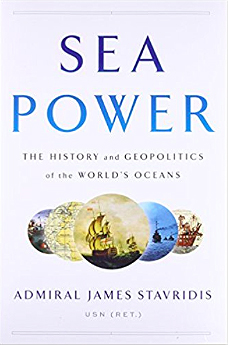 |
The great dominator of this marine space is Australia, which is very much aware of what might happen politically in the island archipelagos in its vicinity. It was Europeans, however, who explored the Pacific well (Magellan was the first, around 1500) and tried to connect it with their world in a way that was not merely transitory and commercial, but stable and lasting.
The United States began its presence in the Pacific with the acquisition of California (1840), but it was not until the annexation of Hawaii (1898) that the huge country was definitively catapulted into the Pacific. The first time this ocean emerged as a total war zone was in 1941 when Pearl Harbour was massacred by the Japanese.
With the return of peace, the Japanese revival and the emergence of China, Taiwan, Korea, Singapore and Hong Kong caused trans-Pacific trade to overtake the Atlantic for the first time in the 1980s, and this trend is still continuing. This is because the Pacific region contains the world's major powers on its shores.
degree program At area geopolitics a major arms race is taking place in the Pacific, with North Korea as a major focus of global tension and uncertainty.
Atlantic: from the Panama Canal to NATO
As for the Atlantic Ocean, Stavridis refers to it as the cradle of civilisation, since the Mediterranean is included among its territories, and even more so if we consider it as the nexus between the peoples of the Americas and Africa and Europe. It has two great seas of great historical importance, the Caribbean and the Mediterranean.
Undoubtedly the historical figure of this ocean is Christopher Columbus, since his arrival in America (Bahamas 1492) initiated a new historical period that ended with practically the entire American continent being colonised by the European powers in the following centuries. While Portugal and Spain concentrated on the Caribbean and South America, the British and the French concentrated on North America.
During the First World War, the Atlantic became an essential transit zone for the war development as the United States transported troops, war materials and goods to Europe during the conflict. It was here that the idea of an Atlantic community began to take shape, leading to the creation of NATO.
As for the Caribbean, the author sees it as a region that is rooted in the past. Its colonisation was characterised by the arrival of slaves to exploit the region's natural resources for purposes of economic interest to the Spanish. In turn, this process was characterised by the desire to convert the indigenous population to Christianity.
The Panama Canal is a driving force for the region's Economics , but Central America is also sailing along the coasts of the countries with the highest violence fees on the planet. Admiral Stavridis sees the Caribbean coast as a kind of Wild West, which in some places has evolved little since the days of pirates, and where drug cartels now operate with impunity.
Since the 1820s, with the Monroe Doctrine, the United States carried out a series of interventions through its navy to bolster regional stability and keep Europeans out of places such as Haiti, the Dominican Republic and Central America. In the 20th century, politics was dominated by caudillos, and soon communism and the Cold War came with them to the Caribbean, with Cuba as ground zero.
Indian Ocean and Arctic: from unknown to risky
The Indian Ocean has less history and geopolitics than the other two great oceans. Despite this, its tributary seas have gained geopolitical importance in the post-World War II era with the rise of global shipping and the export of oil from the Gulf region. The Indian Ocean today could be seen as a region for wielding smart power rather than hard power. While the slave trade and piracy have dwindled almost everywhere, they are still present in parts of the Indian Ocean. It is a region where countries around the world could work together to combat these common problems.
The history of the Indian Ocean does not inspire confidence about the potential for peaceful governance in the years to come. An important core topic to unlock the region's potential would be to resolve the existing conflicts between India and Pakistan (a conflict with the risk of nuclear weapons) and the Shia-Sunni divide in the Persian Gulf, issues that make it a very volatile region. Due to tensions in the Gulf countries, the region is today a kind of cold war between the Sunnis, led by Saudi Arabia, and the Shiites, led by Iran, and between these two sides, the United States, with its Fifth Fleet, is at the centre.
Finally, the Arctic is currently an unknown quantity. Stavridis sees it as both a promise and a danger. Over the centuries, all oceans and seas have been the site of epic battles and discoveries, but there is one exception: the Arctic Ocean.
It seems clear that this exceptionality is coming to an end. The Arctic is an emerging maritime frontier with increasing human activity, rapidly melting ice shelves and significant hydrocarbon resources coming within reach. However, there are major risks that will dangerously condition the exploitation of this region, such as weather conditions, unclear governance due to the confluence of five bordering countries (Russia, Norway, Canada, the United States and Denmark), and geopolitical competition between NATO and Russia, whose relations have deteriorated in recent years.


